The Box Squat
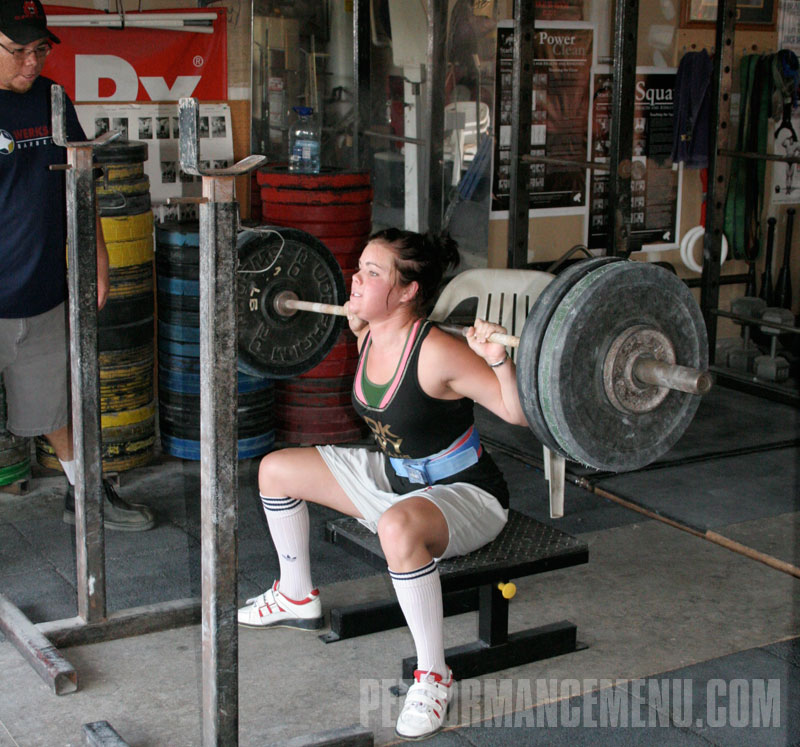
Hours can be spent on the misconceptions of Box Squatting, it has all been heard before. “That really overloads the spine”, “They did that in the sixties, it won’t work today”, or “It’s a new fad that will die out soon”. Humans always tend to shun the things that they do not understand and for that reason, this article will give you some insight into squatting on a box. We will explore the history, instruction, and how to apply Box Squats into your training.
The Box Squat began in Culver City, California at the original Westside Barbell during the 1960s. In 1970, Olympian World Record holder George Frenn squatted 854 lbs in gym shorts at 242 lbs, simply by utilizing a box. But like many other techniques the box never made it to the mainstream public. While everybody was looking for a magic pill or the next new training program, a man by the name of Louie Simmons was training with a proven method of sitting back on a box. The reemergence of the Box Squat was brought about by Louie Simmons the world famous strength training “guru” who operates the present day Westside Barbell out of Columbus, Ohio. He has revolutionized the way people train around the world and the one staple of his program, is the Box Squat.
How do you box squat? A powerlifter must always break parallel, meaning that the hip joint must go just below parallel to the knee joint (use these guidelines to select the correct box height). Start with your feet outside of your shoulders creating a wide base. First, fill your abdomen with air and push out against your belt creating a wide and solid core. Next, push your glutes to the rear; you must always squat back before squatting down. Push your knees out to the sides to activate your hips, this will give maximum leverage in the bottom of the squat. Maintain a tightly arched back as you sit back onto the box. Your shins should be straight up and down or past perpendicular to place all the work on your squatting muscles. Then, once you are completely on the box you must aggressively flex your glutes, hamstrings, abs, and hips off the box creating a tremendous amount of explosive strength. Finally, explode off the box, your head will raise first, make sure to maintain tightness by pushing your head towards your traps and keeping your chest up. Remember that if you try to push with your legs your butt will raise and put you in a good morning position instead of forcefully straight up. Do not push with your legs. Always push with your feet out to the sides and “spread the floor” as you ascend.
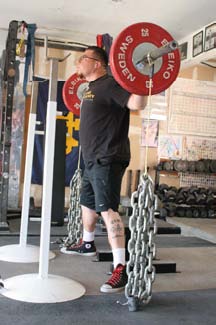
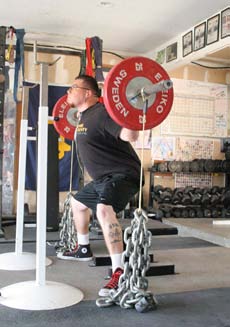
With Box Squats you will build both overall and explosive strength. You can not lift as much with box squats but you will be stressing and utilizing your posterior chain to increase your overall absolute strength. Using a static overcome by dynamic method (by sitting completely on a box and flexing off) produces an incredible amount of explosive strength. Because of this two fold effort, the strength gained by this lift transfers greatly into other lifts (i.e. deadlift, snatch, clean, and free standing squat). Athletes, whether you play baseball, football, volleyball, or tennis, benefits will abound with new explosive speed coming out of a stance.
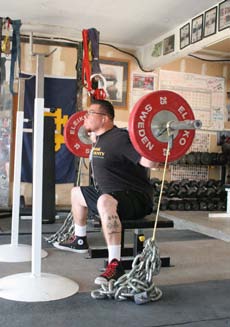
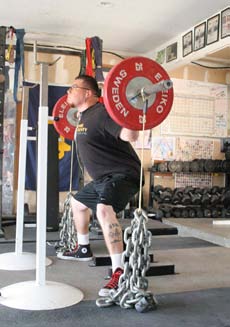
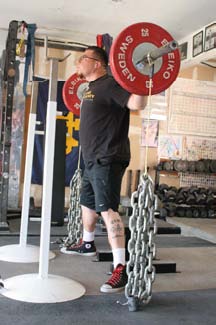
Before you grab your keys and head off to the lumber yard, sit back down and look at how easily you can insert Box Squats into your already extensive training regimen. As a powerlifter it is essential to implement them once a week as a “speed workout”. Complete 8-12 sets of 2 reps with a one minute rest period in between sets. Use 50-60 percent of your one rep max. Apply a 3 week wave starting with 50%, then move up 5% each week. On week four you can institute a deload week or begin another 3 week wave depending on your experience. Remember, Force = Mass x Acceleration, so when it comes to lifting big weights and creating force, speed work can not be overlooked, this will allow you to put up big weight. Many times lifters just need to get aggressive and fast, to get through their sticking points. Every 8-12 weeks it is essential to take a max to adjust your percentages, test your strength, and evaluate your training. In powerlifting it is all about your one rep max, this allows you to perform 8-12 first reps which enable you to perfect your set-up, form, and technique, which transfers directly to the platform. Powerlifters must also perform max effort work taking a 1-3 rep max every 3-5 weeks incorporating different box heights and special bars, on a separate day other than the “speed day”. Keep detailed records and attempt to break your “PR’s” each max effort workout.
I understand not everyone is a powerlifter. To those of you out there who are obsessed with another form of strength or athleticism there are numerous other ways to benefit from the Box Squat. Weightlifter, to compliment your volume of training it is easy to insert a “speed workout” once a week. If you’re aspiring to strength, a session of 5 sets of 5 reps has always worked well. Introducing a box to your front squat training will definitely get you to explode out of “the hole” on cleans and snatches. Experimenting with different heights of boxes can help to improve flexibility as well as working on your “sticking points”. Special bars such as, the cambered bar, buffalo bar, and safety squat bar along with high bar and low bar placement, support the variety and effectiveness of your training. “Max Effort” training (1-3 rep maxes) places great emphasis on absolute strength and is indispensable when it comes to getting strong.
We have explored the history, some instruction, and how to apply the box into your training. I have been told many times not to re-invent the wheel, so here is a time tested, proven method that will increase your squat, pull, and overall strength. Education is key when you are looking to get to the next level, so take this knowledge, apply it and set some records. Of course, I can still hear all the “guru’s” throwing out some excuse or another, but all I can tell you is “load the bar, sit back on a box, and get strong”.
The Box Squat began in Culver City, California at the original Westside Barbell during the 1960s. In 1970, Olympian World Record holder George Frenn squatted 854 lbs in gym shorts at 242 lbs, simply by utilizing a box. But like many other techniques the box never made it to the mainstream public. While everybody was looking for a magic pill or the next new training program, a man by the name of Louie Simmons was training with a proven method of sitting back on a box. The reemergence of the Box Squat was brought about by Louie Simmons the world famous strength training “guru” who operates the present day Westside Barbell out of Columbus, Ohio. He has revolutionized the way people train around the world and the one staple of his program, is the Box Squat.
How do you box squat? A powerlifter must always break parallel, meaning that the hip joint must go just below parallel to the knee joint (use these guidelines to select the correct box height). Start with your feet outside of your shoulders creating a wide base. First, fill your abdomen with air and push out against your belt creating a wide and solid core. Next, push your glutes to the rear; you must always squat back before squatting down. Push your knees out to the sides to activate your hips, this will give maximum leverage in the bottom of the squat. Maintain a tightly arched back as you sit back onto the box. Your shins should be straight up and down or past perpendicular to place all the work on your squatting muscles. Then, once you are completely on the box you must aggressively flex your glutes, hamstrings, abs, and hips off the box creating a tremendous amount of explosive strength. Finally, explode off the box, your head will raise first, make sure to maintain tightness by pushing your head towards your traps and keeping your chest up. Remember that if you try to push with your legs your butt will raise and put you in a good morning position instead of forcefully straight up. Do not push with your legs. Always push with your feet out to the sides and “spread the floor” as you ascend.


With Box Squats you will build both overall and explosive strength. You can not lift as much with box squats but you will be stressing and utilizing your posterior chain to increase your overall absolute strength. Using a static overcome by dynamic method (by sitting completely on a box and flexing off) produces an incredible amount of explosive strength. Because of this two fold effort, the strength gained by this lift transfers greatly into other lifts (i.e. deadlift, snatch, clean, and free standing squat). Athletes, whether you play baseball, football, volleyball, or tennis, benefits will abound with new explosive speed coming out of a stance.



Before you grab your keys and head off to the lumber yard, sit back down and look at how easily you can insert Box Squats into your already extensive training regimen. As a powerlifter it is essential to implement them once a week as a “speed workout”. Complete 8-12 sets of 2 reps with a one minute rest period in between sets. Use 50-60 percent of your one rep max. Apply a 3 week wave starting with 50%, then move up 5% each week. On week four you can institute a deload week or begin another 3 week wave depending on your experience. Remember, Force = Mass x Acceleration, so when it comes to lifting big weights and creating force, speed work can not be overlooked, this will allow you to put up big weight. Many times lifters just need to get aggressive and fast, to get through their sticking points. Every 8-12 weeks it is essential to take a max to adjust your percentages, test your strength, and evaluate your training. In powerlifting it is all about your one rep max, this allows you to perform 8-12 first reps which enable you to perfect your set-up, form, and technique, which transfers directly to the platform. Powerlifters must also perform max effort work taking a 1-3 rep max every 3-5 weeks incorporating different box heights and special bars, on a separate day other than the “speed day”. Keep detailed records and attempt to break your “PR’s” each max effort workout.
I understand not everyone is a powerlifter. To those of you out there who are obsessed with another form of strength or athleticism there are numerous other ways to benefit from the Box Squat. Weightlifter, to compliment your volume of training it is easy to insert a “speed workout” once a week. If you’re aspiring to strength, a session of 5 sets of 5 reps has always worked well. Introducing a box to your front squat training will definitely get you to explode out of “the hole” on cleans and snatches. Experimenting with different heights of boxes can help to improve flexibility as well as working on your “sticking points”. Special bars such as, the cambered bar, buffalo bar, and safety squat bar along with high bar and low bar placement, support the variety and effectiveness of your training. “Max Effort” training (1-3 rep maxes) places great emphasis on absolute strength and is indispensable when it comes to getting strong.
We have explored the history, some instruction, and how to apply the box into your training. I have been told many times not to re-invent the wheel, so here is a time tested, proven method that will increase your squat, pull, and overall strength. Education is key when you are looking to get to the next level, so take this knowledge, apply it and set some records. Of course, I can still hear all the “guru’s” throwing out some excuse or another, but all I can tell you is “load the bar, sit back on a box, and get strong”.
|
Ricardo Costa is 2007 USPF California State Champion at 242 lbs, 2005/2006 USPF CA State Bench Press Champion at 242 lbs, and 2005 USPF CA State Powerlifting Champion at 242 lbs. He is affiliated with Mike’s Gym and Orange County Strength Club. |
Search Articles
Article Categories
Sort by Author
Sort by Issue & Date
Article Categories
Sort by Author
Sort by Issue & Date

